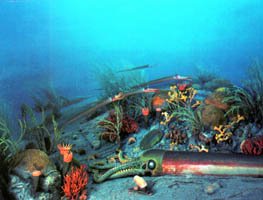
I just picked up a couple more fragments of information on the "Intelligent Design" issue (is it only coincidence that the initials are ID, as in "unconscious mind?") and thought they deserve comment.
It seems those "gaps" they talk about are gaps in the fossil record, as if the theory can be demonstrated only by uncovering the remains of every version of every animal that has ever existed--or at least enough of them so a smooth progression of forms can be laid out in a museum.
Of course, that is asking the impossible. The conditions that produce good fossils are rare and random, and finding them can be quite a task in itself. It's a miracle we have found as many as we have and that careful study of them has revealed as much as it has. Even so, there is plenty of evidence from comparative anatomy of both living and extinct animals to be able to chart their development and their relations to one another.
That's not to say that we fully understand it all yet, or that there may not be surprises in store. It was a recent discovery that the dinosaurs may be more closely related to modern birds than to modern reptiles--that they may in fact have been warm blooded. But this is another example of how our knowledge of the present can help us shed light on the past. Rather than throwing up our hands at the "complexity" of it all and falling back on Divine powers to explain it, we are rewarded by pursuing careful observation and logical analysis.
Another "gap" is the mystery of what happened in the Cambrian period when a tremendous proliferation of new forms of life appeared in the relatively short space of about five million years. Was this God fanning the flames? We don't have a definite answer yet, but there is a fascinating solution put forward by Andrew Parker in his book, In the Blink of an Eye (here's a review).
Observing that the eyeball originated during that time, he proposes that it was the refinement of vision that explains the surge of evolution. Suddenly, geologically speaking, predators could see their prey better and prey could see the predators coming. Mates could find mates by appearance. So issues of coloring, locomotion, speed, and reflexes all became dramatically more important than they had been.
For the purposes of this discussion, it doesn't even matter if Parker is right. It's a wonderful and plausible example of how we can figure things out.
The last "gap" is the supposed lack of evidence for the "primordial soup" of organic chemical compounds in which life, it is thought, first formed. This is admittedly a big missing piece, but we are not without clues. We know so much about the molecular structures of living things that we can begin to make educated guesses about what sort of conditions would be necessary for simpler chemical compounds to link up into something that can reproduce itself. One thought is that lightning may have played a part--how's that for Divine intervention! Dramatic enough for you?
But the eventual proof of this will probably only happen if and when we can recreate it in a laboratory (wait till you hear the screams of protest over that) or if we find it taking place on another planet, which is far less likely to happen. We won't see it here on Earth, of course, because the conditions have changed. The atmosphere we breathe has been created by living things, and is no longer the harsh mix of gases that must have existed In the Beginning.
Maybe if we could just find the Primordial Can that the Primordial Soup came from ...
Wednesday, November 09, 2005
From Primordial Soup to Immemorial Nuts
Posted by
The Nort
at
7:09 AM
![]()
![]()
Labels: Darwin, evolution, intelligent design, science
Subscribe to:
Post Comments (Atom)









No comments:
Post a Comment